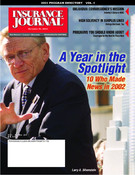A recent report by issued by the Alliance of American Insurers shows that despite the lowest market share in over 20 years, automobile residual market mechanisms in several states continued to burden private insurers in 2000. The report, “Residual Markets Automobile Insurance 2000,” found that he 2000 accident year loss ratio on the private passenger assigned risk plans was 187.8 percent, the highest in the past five years, compared with private insurers’ ratio of 84.6 percent. For other types of residual market automobile plans, which include Joint Underwriting Associations (JUAs), Reinsur-ance Facilities and a State Fund (alternative plans in this report), the total calendar-year loss ratio was 113.5 percent. Market share for the private passenger automobile residual market declined significantly to 1.5 percent from its high point of 8.2 percent in 1990. North Carolina had the largest percentage of its private passenger premium written by the residual market, with 14 percent, followed by Massachusetts, which had 12 percent of its private passenger automobile premium insured in the residual market. The total commercial automobile residual market underwriting loss amounted to $34 million, with New Jersey generating the largest underwriting loss: $14 million. This was followed by Virginia’s $4 million and Hawaii’s $3 million. Eight other states had losses ranging from $1 million to $2 million. These 10 states accounted for 90 percent of the net commercial residual market underwriting losses.
Topics Auto
Was this article valuable?
Here are more articles you may enjoy.


 Longtime Motel 6 Spokesman Tom Bodett Settles Lawsuit Against Chain
Longtime Motel 6 Spokesman Tom Bodett Settles Lawsuit Against Chain  Top National Insurance Journal Stories of 2025
Top National Insurance Journal Stories of 2025  Freight Broker Says $400K in Lobster Meat Stolen in Fictitious Pickup
Freight Broker Says $400K in Lobster Meat Stolen in Fictitious Pickup  Judge Green Lights New York’s Driver’s License Law, Rejecting Trump Challenge
Judge Green Lights New York’s Driver’s License Law, Rejecting Trump Challenge 


